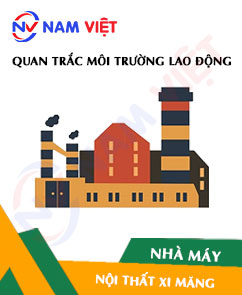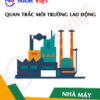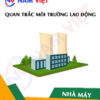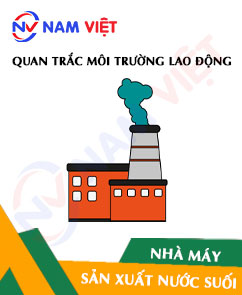Occupational environment monitoring at the cement furniture factory
99,000 ₫
Note: The above price is calculated for one sample, the price may vary depending on the area of the environment that needs monitoring and the movement of the market. For more accurate price support, please refer to the quotation table or contact directly with our consulting staff.
Environmental monitoring of a cement furniture factory is a session of collecting, analyzing, and evaluating factors in the workplace that may harm workers health.
Table of Contents
Toggle1. Overview of cement furniture factory
a. What is a cement furniture factory?
Factory cement furniture is a manufacturing facility specialized in producing furniture products made of cement. This is where cement materials and other components are used to create furniture products such as tables, chairs, coffee tables, bookshelves, cabinets, and other items.
This factory has working rooms, production workshops, storage areas, and necessary equipment and machinery to carry out the cement furniture production process. Technology and production processes may vary depending on the type of product and the scale of the factory.

b. Production stages in a cement furniture factory
In a cement furniture factory, the main production stages include:
- Material preparation: The main material is cement and additives such as sand, stone, structural agents, color additives, and water. These materials are prepared and measured in suitable proportions to create the cement mixture.
- Mixing and stirring: The materials are put into the cement mixer, where cement and additives are combined and stirred evenly to form a homogeneous cement mixture.
- Casting and shaping: The cement mixture is poured into molds or templates to create cement furniture products such as tables, chairs, bookshelves, cabinets, and other items. This stage can use traditional casting technology or vacuum mold casting technology to create precise details and shapes.
- Processing and finishing: After casting, the products are processed and finished to achieve a smoother and more aesthetic surface. Processing steps may include grinding, polishing, sanding, painting, or surface coating to create the final color and finish for the product.
- Quality inspection: After completion, cement furniture products are quality checked to ensure compliance with standards and technical requirements. Factors such as hardness, durability, size, shape, and color are checked to ensure products meet quality requirements and standards.
- Packing and transportation: After quality inspection, cement furniture products are packed and prepared for delivery to sales points or end customers.

c. Types of machinery used in a cement furniture factory
In a cement furniture factory, several types of machinery are commonly used to perform production and processing stages. Below are some popular types of machinery:
- Cement mixer: Cement mixers are used to combine and evenly mix materials such as cement, sand, stone, and additives. The mixer can be a regular mixer or a horizontal mixer, depending on the production scale and requirements.
- Casting and pressing machine: Casting and pressing machines are used to pour the cement mixture into molds or templates to create cement furniture products. These machines may use traditional casting functions or vacuum mold casting technology.
- Grinding and polishing machine: Grinding and polishing machines are used to process the surfaces of cement furniture products, making them smoother and shinier. These machines can adjust speed and grinding pressure to meet the specific requirements of each product.
- Cutting and machining machine: Cutting and machining machines are used to cut and shape cement furniture products into desired forms and sizes. These machines may include cutters, drills, lathes, and other machining tools.
- Painting and surface coating machine: Painting and coating machines are used to paint or coat the surfaces of cement furniture products to create final colors and finishes. These machines may include spray painting machines, paint sprayers, or other coating equipment.
- Inspection and measuring machine: Inspection and measuring machines are used to check quality and measure technical parameters of cement furniture products. These machines may measure hardness, durability, size, and other parameters to ensure product quality.

d. What occupational diseases may workers in a cement furniture factory face?
In a cement furniture factory, workers may suffer from some occupational diseases caused by environmental factors and working processes. Below are some common occupational diseases that workers may encounter:
- Respiratory diseases: Working conditions in a cement factory can affect workers’ respiratory systems. Cement dust, grinding dust, paint spray, and chemicals can cause respiratory irritation, pneumonia, sinusitis, and other respiratory problems.
- Skin diseases: Contact with cement, chemicals, and other materials during cement furniture production can cause skin diseases, including dermatitis, skin irritation, eczema, and other skin problems.
- Bone and joint diseases: Work in cement factories may require workers to lift, transport, and handle heavy materials. This can lead to muscle strain, injuries, and bone and joint diseases such as spinal degeneration, arthritis, and back pain.
- Tropical diseases: In some cases, cement factories may have hot and humid working environments, creating favorable conditions for bacteria and fungi to develop. This can cause skin infections, inflammations, and other health problems.
- Chemical-related diseases: During cement furniture production, chemicals such as thickeners, colorants, fire retardants, antifungal agents, and moisture-resistant substances are used. Long-term or improper exposure to these chemicals can cause health problems such as allergies, dermatitis, organ damage, and other issues.
To protect workers’ health, it is very important to comply with occupational safety regulations, use personal protective equipment, ensure good ventilation and hygiene, provide occupational safety training, and implement risk management.

e. Popular types of cement furniture on the market
Below are some popular types of cement furniture on the market:
- Cement tables and chairs: Cement tables and chairs are made from cement combined with other materials such as wood, steel, or composites. They often have simple, strong designs and are suitable for outdoor spaces.
- Cement plant pots and flower pots: Cement plant pots and flower pots are decorative items used in gardens, yards, or green spaces. They can come in various sizes, shapes, and designs to serve decorative and planting purposes.
- Cement walls: Cement walls are used to build exterior or interior walls. They are highly durable, weather-resistant, and can be finished by painting, grinding, or glazing.
- Cement shelves and cabinets: Cement shelves and cabinets are used to store and display items in interior spaces. They have unique designs and often high aesthetic value, creating highlights for living spaces.
- Cement swimming pools and fountains: Cement swimming pools and fountains are decorative products used in outdoor areas such as gardens or public spaces. They have diverse designs and create beautiful water effects.
- Cement ceramics: Cement ceramics are artistic decorative products made from cement. They can be sculptures, 3D paintings, or other decorative items to create artistic highlights in interior or exterior spaces.
2. Overview of occupational environment monitoring service
a. What is occupational environment monitoring in a cement furniture factory?
Occupational environment monitoring (or workplace environment measurement) in a cement furniture factory is the activity of collecting, evaluating, and analyzing measurement indicators of workplace environmental factors in a cement furniture factory, in order to take timely measures, minimize environmental harm to workers’ health, and prevent occupational diseases. Occupational environment monitoring is a mandatory regulation for cement furniture factories.
Occupational environment monitoring plays the most important role in caring for, protecting, and improving workers’ health because the main resource of the enterprise and the direct source of profit is the workforce. Workers frequently exposed to hazardous factors and occupational risks exceeding permissible standards will have their health affected and may suffer from occupational diseases.
REGISTER FOR OCCUPATIONAL ENVIRONMENT MONITORING SERVICE
b. Occupational environment monitoring program of Nam Viet
The occupational environment monitoring program of Nam Viet is a program researched by monitoring engineers in the field of occupational safety and environmental protection. With the goal of ensuring health and safety for workers, this program uses modern measurement methods to monitor air quality, water, and microclimate, physical, dust… factors in the workplace environment. This is a very important program in ensuring a safe working environment and protecting workers’ health.
In addition, the occupational environment monitoring program of Nam Viet also plays an important role in researching and developing new solutions to improve workplace environmental quality. With the dedication and professionalism of the monitoring expert team, the exclusive monitoring program of Nam Viet is becoming a breakthrough in occupational safety management and environmental protection in Vietnam.

c. Standardization in workplace environment measurement procedures
Standardization in workplace environment measurement procedures of Nam Viet is a very important aspect in ensuring the quality of measurement results. To ensure the accuracy and reliability of measurement results, this program uses recognized standards and standardized procedures of Ho Chi Minh City Department of Health. This ensures that the collected data will be reliably used in workplace environment assessment and decision-making on improving the workplace environment to protect workers’ health.
These standardized procedures also ensure that the measurement results are performed by monitoring specialists with high qualifications and many years of experience, helping managers and experts rely on results from An Toan Nam Viet to make accurate and valuable decisions in protecting workers’ health and the environment.
With the application of standardization in workplace environment measurement procedures, Nam Viet demonstrates its commitment to ensuring a safe working environment and protecting workers’ health, while also positively contributing to the development and improvement of occupational safety management and environmental protection in Vietnam.
d. Occupational environment monitoring report of cement furniture factory
Occupational environment monitoring results are prepared according to Form No. 04 Appendix III issued with Decree 44/2016/ND-CP and are made in 02 copies: 01 copy sent to the labor facility that signed the contract to perform occupational environment monitoring and 01 copy kept at the organization performing occupational environment monitoring.
The retention period for occupational environment monitoring results is indefinite according to legal regulations.

e. Frequency of occupational environment monitoring according to legal regulations
According to Clause 2 Article 18 of the Law on Occupational Safety and Hygiene 84/2015/QH13, employers must organize occupational environment monitoring to assess harmful factors at least once a year.
f. Deadline for submitting occupational environment monitoring report according to legal regulations
The deadline for report submission is before December 31 every year. Enterprises in production facilities are required to submit occupational environment monitoring reports to the Department of Health at the locality where the production facility, business headquarters, and workers are located.
When there are changes in technology processes, production processes, or when renovating or upgrading workplaces that may generate new harmful factors to workers’ health, enterprises in production facilities must update occupational hygiene records on relevant harmful factors that require occupational environment monitoring.
g. Regulations on penalties for violations of occupational environment monitoring by employers
According to Article 27 of Decree No. 12/2022/ND-CP dated January 17, 2022 on administrative penalties in the fields of labor, social insurance, and Vietnamese workers working abroad under contracts.
- Clause 2: Fine from 2,000,000 – 5,000,000 VND for employers who do not publicly announce to workers at the occupational environment monitoring location and the inspected, evaluated, and managed hazardous factors immediately after occupational environment monitoring results and hazardous factor assessment results at the workplace are available.
- Clause 3: Fine from 20,000,000 – 40,000,000 VND for employers who fail to conduct occupational environment monitoring to control health hazards for workers as required by law.
- Clause 4: Fine from 40,000,000 – 60,000,000 VND for employers colluding with occupational environment monitoring organizations to commit fraud in monitoring activities but not to the extent of criminal prosecution.
3. Harmful environmental factors for workers in cement furniture factory
Workers in cement furniture factory may be exposed to the following harmful environmental factors:
- Cement dust: The cement furniture production process can generate cement dust in the air. Inhaling cement dust may irritate the respiratory system, cause respiratory problems, pneumonia, and occupational lung diseases.
- Chemicals: During cement furniture production, chemicals such as adhesives, cleaners, waterproofing agents, and paints may be used. Prolonged exposure to these chemicals can negatively affect health, such as skin irritation, respiratory issues, and nervous system problems.
- Noise: Machinery and production processes in cement furniture factory can generate high noise levels. Continuous and intense noise may cause stress, reduce concentration, and damage workers’ hearing.
- Humidity and temperature: Some stages of cement furniture production require specific humidity and temperature conditions. Uncomfortable environmental conditions such as high humidity, excessively hot or cold temperatures may cause discomfort and affect workers’ health and performance.
- Physical impacts: Work in cement furniture factory may require heavy physical activity, lifting heavy objects, and working in uncomfortable positions. This may cause muscle strain and lead to musculoskeletal injuries, back pain, and spinal problems.
REGISTER FOR OCCUPATIONAL ENVIRONMENT MONITORING SERVICE
4. Measures to improve the working environment in cement furniture factory
To improve the working environment in cement furniture factory and protect workers’ health, the following measures can be implemented:
- Ensure ventilation and exhaust fan system: Install ventilation and exhaust fan systems to remove dust and toxic gases from the air. This helps reduce the risk of exposure to cement dust and harmful chemicals.
- Use dust extraction system: Set up an effective dust extraction system to remove cement dust and chemicals from the production process. This system can be integrated with machinery and production equipment to prevent airborne dust.
- Provide protective equipment: Provide protective equipment such as masks, safety glasses, gloves, and chemical-resistant clothing to prevent direct exposure to cement dust and harmful chemicals.
- Occupational safety training: Ensure that all employees receive occupational safety training and clearly understand preventive measures and how to use protective equipment. This helps increase awareness and compliance with safety rules during work.
- Regular inspection and maintenance of machinery: Conduct regular inspection and maintenance of machinery to ensure safe and efficient operation. This reduces the risk of incidents and ensures a safe working environment for employees.
- Create comfortable working conditions: Ensure that the working environment has comfortable humidity and temperature levels. This helps reduce muscle strain and increase workers’ concentration.
- Risk assessment and management: Conduct risk assessment of the working environment and apply management measures to minimize risks and ensure workers’ safety.
- Encourage the use of safe technologies and processes: Apply safe production technologies and processes such as automation to minimize direct exposure to harmful factors and enhance safety in work processes.
- Periodically organize occupational environment monitoring in factories, collect and analyze harmful factors for workers, and then adjust to reduce hazards to prevent occupational diseases for them.
5. Benefits of periodic monitoring in cement furniture factory
An Toan Nam Viet provides businesses with excellent benefits when using occupational environment monitoring services as regulated in Decree 44/2016/ND-CP on the management and control of harmful factors in the working environment affecting workers.
- Businesses can proactively control harmful factors at workshops or factories.
- Receive consultation and recommendations on measures to minimize harmful factors and improve the quality of the working environment.
- Indirectly protect human resources, the key factor in business development.
- Minimize the impacts of occupational diseases on human health, thereby reducing future medical treatment costs.
- Improve workers’ health, which leads to better product quality and stable productivity.
- Comply with occupational safety regulations, avoiding legal risks.
- Create credibility and professionalism in all aspects, thereby enhancing the business brand.
The occupational environment monitoring service of Nam Viet is the solution to minimize the impacts of occupational diseases, contributing to creating a fresh and high-quality working environment.

6. National occupational environment monitoring center
Occupational environment monitoring center of Nam Viet is a professional unit in monitoring and measuring the quality of the working environment across all provinces and cities in Vietnam. With a team of experienced monitoring specialists, the center uses modern measuring equipment, ensuring accuracy and reliability.
In addition to providing monitoring services, the center also supports customers in planning, handling, and monitoring occupational environment issues. With the motto “customers are the center,” the center focuses on customer satisfaction, meeting all customer needs, and committing to providing the best solutions for businesses.
REGISTER FOR OCCUPATIONAL ENVIRONMENT MONITORING SERVICE
With investments in technology, equipment, and human resources, Nam Viet’s monitoring center has been and is becoming one of the reputable units in occupational environment monitoring in Ho Chi Minh City with the following objectives:
- We always value brand reputation and the quality of our products and services.
- We provide customers with the best and most suitable solutions possible.
- Together with a team of experienced Masters and Engineers, we aim to protect the environment and bring benefits to businesses.
- With Nam Viet Occupational Environment Monitoring team, your company will receive professional services from experts in monitoring, along with the best cost benefits.
The occupational environment monitoring process at Nam Viet includes the following basic steps:
- Before conducting occupational environment monitoring, our company always ensures that machinery and equipment for monitoring are adjusted and calibrated in accordance with the law.
- Strictly follow the occupational environment monitoring process committed to the Department of Health.
- Report occupational environment monitoring results honestly to employers.
- In case the occupational environment monitoring results are unsafe for workers, Nam Viet will support providing remedial solutions, and the workplace will implement as follows:
- Implement measures to improve working conditions to minimize the impact of harmful factors and prevent occupational diseases.
- Organize health examinations to detect early occupational diseases and related illnesses for workers in unsafe working environments.
- Provide material allowances for workers in accordance with labor law regulations.

7. Occupational environment monitoring service quotation
To help businesses carry out occupational environment monitoring professionally and effectively, Nam Viet provides customers with a service quotation for occupational environment monitoring with quality and reasonable cost.
- Our monitoring quotation provides detailed information about the pricing of the monitoring services we offer, including costs related to transportation, measurement, analysis, and reporting. Customers can be completely assured of the accuracy and reliability of the monitoring reports we provide.
- We are committed to always offering the most competitive and reasonable prices in the market, and we are always ready to consult and answer all questions about monitoring services promptly and professionally.
- With Nam Viet’s monitoring quotation, customers can easily select service packages suitable for their needs. We are committed to bringing customers the highest satisfaction with professional service quality.
No comments yet












Review Occupational environment monitoring at the cement furniture factory
There are no reviews yet.